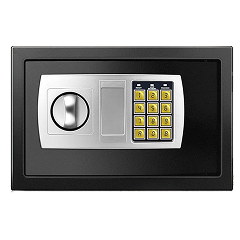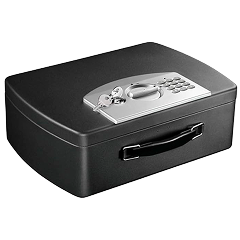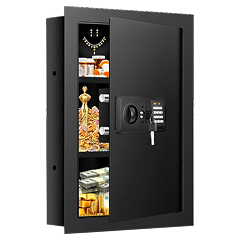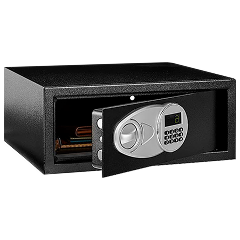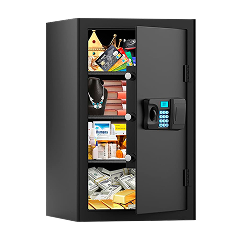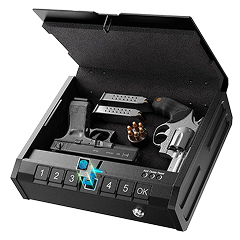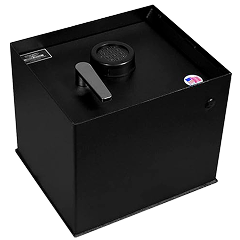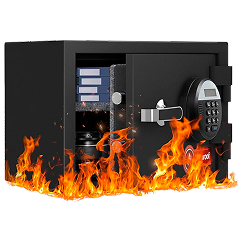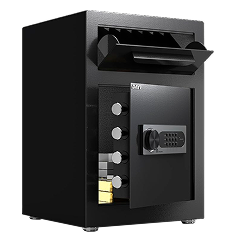Je suis ingénieur et avant, je voyageais beaucoup pour le travail. J’ai également deux types de coffres différents à la maison et j’ai appris que les coffres-forts portables règlent des problèmes dont on n’a même pas conscience avant d’en avoir un. À la base, j’ai acheté mon coffre-fort portable avec verrou pour des voyages d’affaires, pendant lesquels j’avais besoin de laisser mes documents et mes disques durs dans la chambre.
Mon coffre-fort à combinaison pèse une quarantaine de kilos et ne quitte jamais la maison, mais le fait d’utiliser les deux m’a appris ce qui différencie vraiment les unités portables des coffres-forts de petite taille. La portabilité n’est pas une simple question de taille mais d’équilibre entre sécurité et praticité.
Les gens pensent que n’importe quel coffre-fort de petite taille est considéré comme portable, mais avoir un modèle à clé et à accès rapide en plus d’un modèle à combinaison m’a montré qu’il n’y a pas que les dimensions et le poids qui comptent.
Ce guide se concentre sur ce qui différencie les coffres-forts portables des modèles fixes, de la manière dont la résistance aux impacts affecte leur déplacement, à pourquoi le mécanisme de fermeture que vous choisissez à une importance sur votre routine et votre tranquillité d’esprit quand vous n’êtes pas chez vous.
Facteurs de mobilité : taille, poids et options de déplacement
La science des coffres portable implique de trouver un équilibre entre sécurité et mobilité.
Equilibre entre dimensions et capacité
Mon coffre-fort ignifugé mesure environ 40 cm de hauteur sur 30 cm de largeur et 18 cm de profondeur, il rentre parfaitement dans une grosse valise et dans un coffre de voiture, mais les modèles plus gros deviennent très compliqués à déplacer. Les coffres-forts portables sont plus efficaces quand ils ont la taille idéale pour tous vos vrais objets de valeur et pas pour tout ce que vous pourriez vouloir protéger. Les dimensions idéales vous permettent d’y ranger un petit ordinateur portable, vos documents importants ainsi que de petits appareils électroniques sans transformer la session rangement en Tetris.
Tenir compte du poids pour la mobilité
Voici les leçons que les deux coffres m’ont appris : mon coffre-fort à combinaison d’une quarantaine de kilos est « portable » dans le sens où deux personnes peuvent le déplacer, mais assez lourd pour qu’un voleur ne puisse pas partir avec facilement.
Mon coffre-fort ignifugé léger pèse une dizaine de kilos et je peux le porter à une main, mais ça le rend facile à voler. Le poids idéal d’un coffre portable dépend de vos besoins. Si vous voyagez, mieux vaut opter pour un modèle léger mais pour une utilisation temporaire à la maison, mieux vaut qu’il fasse un certain poids.
Les caractéristiques de mobilité vraiment importantes
La plupart des coffres-forts portable ont une poignée simple mais après avoir trimballé le mien un moment, j’ai fini par savoir quelles caractéristiques font une vraie différence. Mon coffre-fort ignifugé a une seule poignée sur le dessus, très bien pour les petites distances, mais qui devient rapidement inconfortable.
Des poignées latérales encastrées ou une bandoulière seraient beaucoup plus pratiques si on a besoin de porter le modèle pendant un long moment. Certaines unités ont même des poignées rembourrées ou des roues, mais je ne les ai jamais testées. Le plus important, c’est de s’assurer que le système de transport résiste au poids du coffre sans problème, parce que lâcher son coffre portable à cause des poignées peut vite devenir pénible.
Mécanismes de verrouillage pour les modèles portables
Quand vous déplacez régulièrement votre coffre, le verrouillage devient le point d’interaction le plus fréquent et peut donc potentiellement devenir défaillant.
Les verrous à clé, simples et efficaces
Mon petit coffre ignifugé a un verrou à clé traditionnel et après deux ans d’utilisation, j’apprécie sa simplicité. Pas de pile qui risque de se vider, pas de risque d’oublier la combinaison et le système s’ouvre en deux secondes.
Mais si vous perdez la clé, vous ne pourrez plus ouvrir votre coffre. Quelqu’un pourrait également emprunter la clé pour créer un double. Les verrous à clé fonctionnent très bien pour un accès rapide dans des endroits comme des chambres d’hôtel, il faut simplement faire attention à ne pas laisser la clé près du coffre.
Les verrous à combinaison, durables sans élément externe
Mon gros modèle de coffre avec verrou à combinaison fonctionne très bien, mais il faut un peu d’entraînement pour le faire tourner de manière fluide et quand je suis pressé, j’ai du mal à entrer les bons chiffres. Ces verrous ne peuvent pas être ouverts aussi facilement que les verrous à clés et aucun risque de perdre la clé ou que quelqu’un fasse un double.
Ils sont plus lents à ouvrir qu’un verrou à clé et il faut assez de lumière pour pouvoir lire les chiffres. Pour les coffres-forts portables, les verrous à combinaison sont pratiques si vous n’accédez pas fréquemment au contenu, mais le transport peut légèrement déplacer le cadran et le désaligner.
Les verrous numériques, pratiques mais vulnérables
Je n’ai jamais eu de coffre avec verrou numérique mais j’ai fait pas mal de recherches à leur sujet vu leur popularité. Imaginez le cauchemar : les piles lâchent pendant un voyage et vos piles de rechange sont dans le coffre.
Les verrous numériques s’ouvrent plus vite que les verrous à combinaison et permettent d’enregistrer plusieurs codes d’utilisateur, ce qui les rend pratique si plusieurs personnes doivent pouvoir y accéder. Certains d’entre eux vous avertissent quand les piles sont en fin de vie et proposent des ports de chargement externes, mais chaque fonctionnalité supplémentaire augmente le risque de défaillance.
Durabilité et résistance aux impacts
Les coffres-forts portables ont des contraintes que les modèles fixes n’ont pas. Ils ont plus de risques de chute, de choc, et d’usure puisqu’on les déplace régulièrement.
Mon coffre-fort ignifugé a pris quelques chocs à force de le mettre dans la voiture, de le sortir, etc., et chaque impact me rappelle pourquoi la qualité de la construction est plus importante pour les unités portables. Ce sont les coins qui ont pris le plus de chocs, les bords renforcés ne sont donc pas simplement là dans un but esthétique.
L’épaisseur de l’acier est une question d’équilibre, des murs plus épais offrent plus de sécurité mais aussi plus de poids à porter. Mon coffre ignifugé léger utilise un acier plus fin que mon coffre à combinaison et on sent la différence. Le coffre portable a une légère flexibilité latérale, contrairement à la version fixe.
Pour les documents et appareils électronique, ce niveau de protection suffit amplement mais si vous avez quelque chose d’assez précieux pour justifier l’achat d’un petit coffre portable, cherchez des modèles en acier de calibre 12 au minimum.
Le vrai test de la durabilité des coffres-forts portables vient plutôt des utilisations répétées que d’événements dramatiques. Les gonds ont du jeu, la serrure devient difficile à ouvrir et les couches protectrices sont usées suite à un contact constant. Les fixations de la poignée de mon coffre portable ont des marques à cause d’une utilisation régulière, et je me demande combien de temps elles vont tenir. Des gonds encastrés et des mécanismes de serrure protégés survivent mieux à l’usure que les composants exposés.
Capacité et organisation dans les modèles compacts
Les fabricants de coffres-forts portables adorent promouvoir la taille en mètres cubes, mais ces chiffres indiquent rarement l’espace utilisable. Mon coffre-fort mobile affirme offrir une capacité de 16 litres environs, mais l’intérieur paraît beaucoup plus petit avec les bords épais, le mécanisme et la forme rectangulaire qui n’est pas la plus efficace pour la plupart des objets.
J’ai rapidement compris qu’il fallait plutôt mesurer ses objets plutôt que de faire une confiance aveugle au fournisseur. Mon iPad rentre à peine en diagonale et ajouter un tas de documents rend l’espace très serré.
La disposition interne détermine l’espace que vous pourrez vraiment utiliser. Mon coffre-fort à combinaison a des parois totalement plates à l’intérieur, ce qui maximise l’espace mais qui peut aussi causer aux éléments de glisser et de se perdre dans les coins pour les plus petits d’entre eux. Certains coffres-forts portables ont des systèmes d’organisation pour rendre l’espace plus fonctionnel malgré sa taille :
- Porte-documents ou trombones pour que tous vos papiers restent ensemble et accessibles
- Inserts en mousse ajustables dans les compartiments pour éviter les dégâts à vos objets électroniques
- Poches intérieures ou bandes élastiques pour protéger les petits objets comme les clés USB, les bijoux ou l’espèce
- Plateaux et séparateurs amovibles pour créer plusieurs niveaux de stockage sans compartiments permanents
- Surfaces rembourrées pour protéger les objets fragiles et réduire le bruit lors des déplacements du coffre
Une bonne organisation est plus importante pour les coffres-forts portables puisqu’on les ouvre plus régulièrement et qu’on y stocke des objets dont on a besoin rapidement et pas forcément à long terme.
Versatilité et adaptabilité
Les meilleurs coffres-forts mobiles offrent plusieurs options de fixation et de protection qui vous permettent de vous adapter à différentes situations sans compromettre la sécurité. Aucun de mes deux coffres n’offre de câble antivol ou de système d’ancrage, mais j’ai fait suffisamment de recherches sur ces fonctionnalités parce qu’elles règlent le problème le plus important des coffres-forts portables : leur mobilité les rend faciles à voler.
Les câbles antivols qu’on peut fixer à un cadre de lit, les pieds d’un bureau ou un point d’ancrage dans un véhicule ne freineront pas un voleur déterminé qui a les bons outils, mais ils empêchent les vols d’opportunité. Vous pouvez trouver des modèles dont le câble s’enlève quand vous n’en avez pas besoin, ou avec des points d’ancrage permanents qui fonctionnent avec les câbles de sécurité classiques. L’important, c’est d’avoir un produit flexible pour différentes situations comme un séjour temporaire à l’hôtel, un montage semi permanent dans un véhicule ou à la maison, sans avoir besoin de percer le sol.
Voyages et conformité avec la sécurité dans les aéroports
Si je n’ai personnellement jamais voyagé à l’étranger avec mon coffre-fort portable, les consignes de sécurité en matière d’armes à feu créent des exigences spécifiques ayant un impact sur la sélection de coffre pour ceux qui voyagent avec.
Les armes à feu doivent être placées dans un contenant fermé et rigide auquel seul le propriétaire a accès (avec une clé ou une combinaison). Les systèmes qu’un agent externe peut ouvrir ne conviendront pas au transport d’armes. Ça élimine de nombreux modèles de coffres-forts portables avec un câble antivol ou une construction fragile, et ça force les voyageurs à opter pour des modèles plus lourds et plus durables qui résistent aux passages en soute.
Pour les déplacements en voiture, la résistance aux vibrations est plus importante que ce qu’on imagine. Le verrou mécanique de mon coffre à combinaison est parfois mal aligné après un déplacement, ce qui me force à réinitialiser le système avant l’ouverture.
Un coffre-fort portable qui balade pendant des heures dans le coffre d’une voiture pourrait avoir le même problème que les verrous mécaniques et les verrous électroniques pourraient avoir des soucis de connexion de batterie ou d’usure sur les composants internes. Les points d’ancrage doivent également pouvoir résister à une vibration constante sans devenir lâches.
Les idées reçues sur la sécurité des coffres-forts portables
Les contenus publicitaires et les avis en ligne exagèrent souvent sur les capacités réelles des coffres-forts mobiles comparés à leurs congénères plus lourds et installés de manière permanente.
Les limitations par rapport aux modèles de grande taille
Mon coffre-fort à combinaison de 40 kilos offre une sécurité supplémentaire avec son poids et sa construction en acier épais, mon coffre-fort mobile ne peut pas rivaliser, peu importe ce qu’affirme le constructeur. Les modèles portables sacrifient une part de sécurité au nom de la praticité.
Ils peuvent protéger vos objets de valeur contre le feu ou les inondations, mais n’arrêteront pas quelqu’un qui a du temps, des outils et de la détermination. Les parois en acier léger permettent la portabilité mais créent aussi des vulnérabilités que n’ont pas les modèles fixes. Et leur poids léger permet à n’importe qui d’emmener l’unité et d’essayer de l’ouvrir plus tard.
Ce que dit le marketing et ce que dit la réalité
J’ai vu des coffres-forts portables présentés comme résistants à l’ouverture et aux vols, mais après avoir utilisé les deux types de modèles, je trouve qu’il faut un contexte. Mon coffre ignifugé a des espaces autour de la porte qu’on peut exploiter avec un outil, ce qui n’est pas le cas de mon gros modèle fixe.
La résistance au feu des modèles est souvent exagérée. Certains coffres portables indiquent une protection au feu sans tests UL, ou une protection à des températures plus basses et pendant moins longtemps qu’avec un vrai incendie. L’aspect « waterproof » est également contestable parce que la plupart des coffres-forts portables résistent aux éclaboussures et aux immersions courtes, pas aux inondations prolongées en cas de véritable urgence.
Avoir des attentes réalistes en matière de sécurité
Les coffres-forts portables permettent d’éviter que quelqu’un fouine, ralentissent les vols et protègent le contenu des dégâts environnementaux. Mon coffre-fort ignifugé protège les documents importants en cas de petit incendie domestiques et empêche les gens de fouiller dans mes affaires mais n’empêchera pas quelqu’un de le voler.
Pour bénéficier d’une bonne sécurité, il faut éviter de crier sur les toits que vous avez un coffre-fort et l’utiliser pour des objets qui ne valent pas la peine de le forcer, comme des disques durs externes ou des documents, plutôt que des bijoux ou une grosse quantité de liquide.
Choisir le coffre-fort portable le mieux adapté à vos besoins
Avoir un coffre-fort mobile et ignifugé ainsi qu’un gros modèle à combinaison m’a appris que le « bon » modèle portable dépend surtout de la façon dont vous l’utiliserez.
- Vous avez besoin d’un coffre-fort pour des déplacements occasionnels ou un stockage temporaire de documents ? Optez pour la version légère avec un accès rapide et une bonne organisation pour un maximum de sécurité.
- Pour une utilisation domestique semi-permanente, où vous risquez de déplacer occasionnellement le coffre mais où il vous faut une meilleure protection ? Prenez un modèle lourd en acier épais et plus solide.
- Choisissez le type de serrure selon votre méthode d’accès avec des clés pour une utilisation fréquente, une combinaison pour une sécurité plus poussée et un accès plus lent, et un système électronique si vous acceptez de surveiller la durée de vie des piles ou de la batterie.
J’utilise les deux coffres selon mes besoins, le coffre portable décourage les vols et contient des choses qui ont besoin d’être protégées des éléments alors que le modèle fixe et plus lourd est réservé aux objets de valeur.
Les meilleurs coffres-forts portables sont ceux qu’on peut utiliser de manière régulière, pas ceux qui sont les plus sécurisés mais perdent énormément en praticité. Pensez aux risques de manière réaliste, à la fréquence à laquelle vous accéderez aux contenus et aux exigences en matière de mobilité au lieu de vous laisser séduire par un marketing trompeur avec des fonctionnalités dont vous n’aurez pas besoin.


